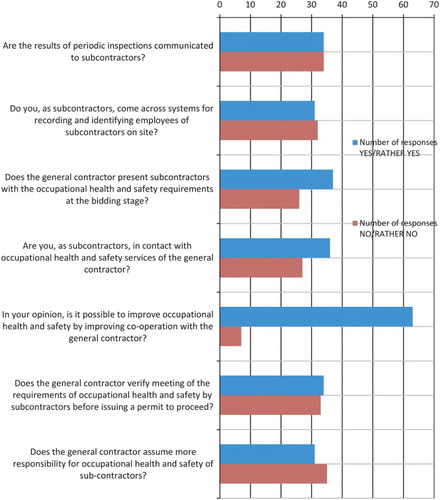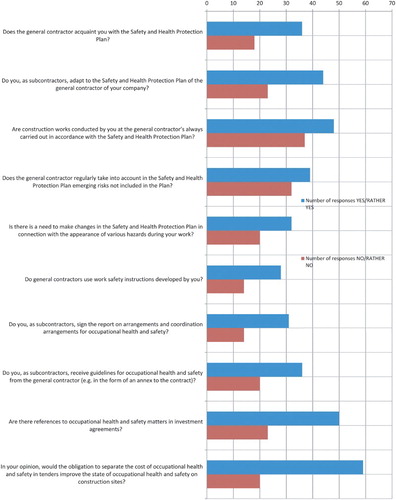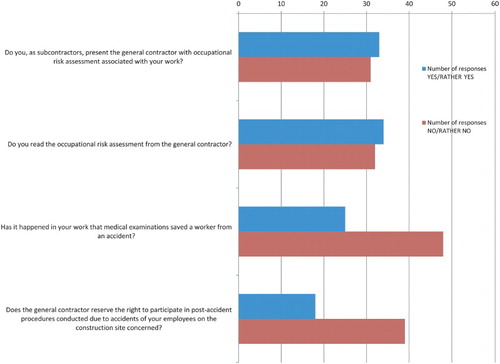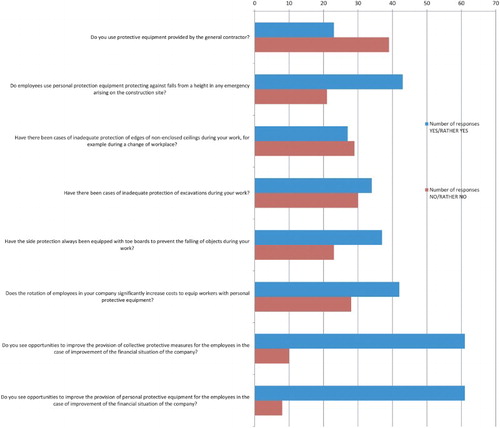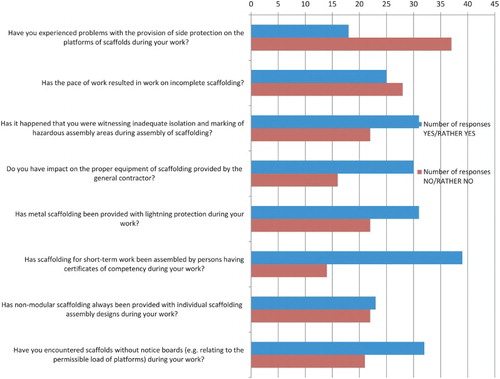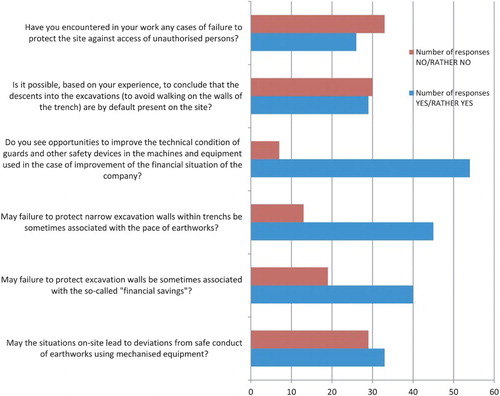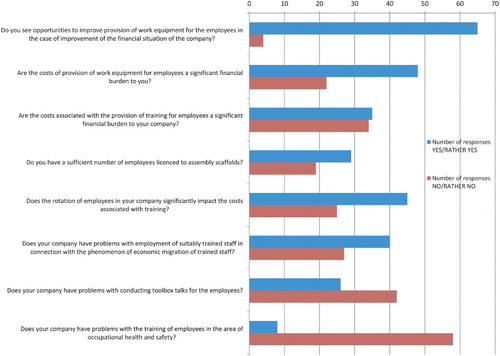Abstract
The construction industry is a booming sector of the Polish economy; however, it is stigmatised by a lower classification due to high occupational risks and an unsatisfactory state of occupational safety. Safety on construction sites is compromised by small construction firms which dominate the market and have high accident rates. This article presents the results of studies (using a checklist) conducted in small Polish construction companies in terms of selected aspects of safety, such as co-operation with the general contractor, occupational health and safety documents, occupational risk assessment, organization of work, protective gear and general work equipment. The mentioned studies and analyses provided the grounds to establish the main directions of preventive measures decreasing occupational risk in small construction companies, e.g., an increase in engagement of investors and general contractors, improvement of occupational health and safety (OSH) documents, an increase in efficiency of construction site managers, better stability of employment and removal of opposing objectives between economic strategy and work safety.
1. Introduction
The construction industry is a booming sector of the economy. However, according to European data, the industry is classified among the sections of the economy presenting high occupational risks and an unsatisfactory state of occupational safety. Workers in the construction sector are more exposed to biological, chemical and ergonomic risk factors, as well as the effects of noise and temperature. Approximately 45% of workers in the construction sector say that their work has a negative impact on their health.[Citation1] The construction industry is subject to high occupational risk and high rates of occupational accidents, occupational diseases and absenteeism at work. In Europe, according to Eurostat data for 2011 (for 28 European Union [EU] countries), the fatal accident rate was 6.39 (per 100,000 persons in employment) in the construction industry, with an average of 1.94 in all activities (Nomenclature statistique des Activités économiques dans la Communauté Européenne [NACE]).[Citation2] This is also confirmed by Poland's General Labour Inspector [Citation3] with reports which show that construction workers are often subject to fatal accidents at work ().
Figure 1. Victims of fatal accidents in 2011 in Poland by occupation (%).[Citation3]
![Figure 1. Victims of fatal accidents in 2011 in Poland by occupation (%).[Citation3]](/cms/asset/887ada3c-36d4-478c-b885-36e1b3e73fb7/tose_a_1085206_f0001_c.jpg)
Implementation of the majority of construction projects involves more than one subcontractor. Among the companies involved in the construction sites, small construction companies dominate both in Europe and Asia as well as in the USA. Research indicates that those companies significantly affect the development of safety on construction sites because they have higher accident rates compared with large construction companies.[Citation4]
1.1. State of the art
In connection with the occurrence of high occupational risk in the construction industry, it is important to take the necessary steps to reduce this exposure. These actions may be related to the introduction of a system of procedures for monitoring safety on construction sites. This system could impose strict rules of conduct for both the general contractor and its subcontractors in a comprehensive manner to enable an elimination of hazards from the construction site or a reduction of associated risks.[Citation5] The research also shows that many accidents can be avoided by developing a proper concept of safety assurance at the design stage.[Citation6,Citation7]
An important role in the reduction of occupational risk on the construction site is played by the introduction of high standards of safety at work coupled with the co-operation of experienced workers and their immediate superiors.[Citation8–10] These standards can be established at the stage of drawing up the building permit (taking into account the specifics of the works planned for execution).
Establishment of these standards is essential for determining the organization of works (procedures and principles of occupational health and safety, in addition to human resources – including the knowledge or experience or the individual features of employees). Furthermore, effective training of employees may be the solution for improving those standards on the construction site.[Citation11] Training programmes should be evaluated and improved, taking into account the effects obtained in the form of limitation of occupational risk (also associated with dangerous behaviour of employees) and increase in satisfaction of employees with their work and their performance.
Efforts are also being made to introduce modern yet costly technical solutions to improve safety on the construction site. Such a solution can include mobile systems for the monitoring of staff and work equipment aimed, e.g., at preventing falls from a height.[Citation12]
Past practice indicates that research in the area of improvement of safety in the construction industry is much more focused on large construction companies.[Citation4] Less attention is paid to small companies (including sole proprietorships) that perform their work in houses of private owners and during the implementation of major investment projects. It should be noted that more than 99% of construction companies in the EU are small and medium enterprises (SMEs). According to data from Poland's National Labour Inspectorate,[Citation13] small and economically weak operators play a significant part in the construction process, often executing specific work as subcontractors. They are characterised by high staff turnover and shortages of people with relevant experience and occupational qualifications. Thereby, those companies have an adverse effect on injury statistics. There are, however, exceptions to this rule. For example, a study in Spain showed that work in large construction companies is not always safer than in small firms.[Citation14] The data presented by the Council of Labour Affairs of the Taiwanese Central Government from the years 2000–2007 indicate that the factors influencing the occurrence of accidents in small construction companies include skills of occupational safety management, the importance attached by employers to issues of health and life of employees and the level of compliance with the laws on work safety.[Citation15] According to data from Poland's National Labour Inspectorate,[Citation16] 600 owners of construction companies claim that causes of increased number of accidents in the industry primarily include disregard of the principles of occupational health and safety by employees (58%), haste and organizational chaos resulting from the need to meet investment deadlines (38%), low awareness of occupational hazards of employees (24%) and high staff turnover (21%). A much smaller percentage of company owners indicated the reasons attributable to the employer, such as reluctance to incur the cost of protection of workplaces (19%) or poor supervision over employees (11%). The presented reasons for the increased number of accidents also included legislation preferring the cheapest bidders in public procurement (11%).
1.2. Research aims and hypotheses
The aim of this research in small Polish construction companies was to analyse the status of the injury risks occurring in small construction enterprises.
The research hypothesis was as follows: economic and organizational aspects in an activity of small construction companies in Poland contribute to the increase of occupational risk during work tasks carried out by their employees.
2. Research methods
The study of small construction companies was preceded by an analysis of the causes of accidents occurring at different positions in small construction companies, mainly using data on accidents from the National Labour Inspectorate, the Central Statistical Office and the European Union (Eurostat).
Based on the results of the analysis, a checklist was developed to study the state of occupational health and safety in small construction companies. The checklist included different aspects identified during the analysis of accident statistics and descriptions. A fragment of the checklist is presented in .
Table 1. Part of the checklist used for research in small construction companies.
The results of studies using the checklist were verified by construction experts representing both general contractors (large construction companies) and subcontractors (small construction companies).
3. Range of research methods
The checklist contains 111 questions assigned to particular aspects of occupational health and safety (i.e., organization of co-operation of small companies with the general contractor; documents of small construction companies improving or assuring the state of occupational health and safety; hazard identification and occupational risk assessment, as well as accidents and diseases; organization of work in companies; the use of technical measures of protection against hazards; the use of scaffolding; conduct of construction works, in particular earthworks; training of employees; and the use of machinery and equipment). The checklist also includes questions about the nature and scope of the studied company and the specific work of a given person from the company providing the information.
With the use of this checklist, studies were conducted with representatives from 82 small construction companies. These included business owners (29 persons), supervisors – including construction site managers (40 persons) – and employees of companies (13 persons) – including health and safety inspectors and specialists. Companies participating in the study (with a various and wide range of activities) declared conduct of reinforcement works (32 companies), carpentry works (33 companies), roadworks (27 companies), finishing and masonry works (43 companies), earthworks and excavation works (41 companies), and servicing with the use of road construction equipment and earthmoving equipment (33 companies). Moreover, the companies declared execution of other works such as electric and sanitary installations, insulation works, carpentry works, concrete works, transport services, waterproofing for construction purposes and erection of steel structures. The surveyed companies have their location in the Polish provinces characterised by high accident rates.
4. Results
The figures present representatives of small construction companies who answered the questions from the checklist. Not all representatives answered all questions and for this reason the sum of answers is not the same.
4.1. Study of small construction companies using the checklist
The results show the problems occurring in the co-operation between general contractors and subcontractors (). In particular, this applies to communication of the results of periodic inspections of construction sites to subcontractors, systems for monitoring subcontractors' employees on site, presenting the subcontractors with requirements for occupational health and safety at the bidding stage of the tender, contact of subcontractors with occupational health and safety services of the general contractor and the lack of greater involvement of general contractors in health and safety matters of the subcontractors, and checking of compliance of subcontractors with occupational health and safety requirements. Generally, most of the subcontractors see the possibility of improving health and safety conditions by enhancing co-operation with the general contractor.
In terms of the documentation aimed at improving occupational health and safety (), there are also opportunities to improve the current state of safety. This can be accomplished by improving co-operation between the general contractor and subcontractors through the development of the Safety and Health Protection Plan and work safety instructions, the development of health and safety coordination arrangements, the implementation of guidelines for subcontractors and the keeping of relevant records in the investment agreements. An effective way to improve safety is also proper conduct of risk assessment by subcontractors and co-operation in this field with general contractors ().
The studies of organizational aspects of small construction companies () show that the representatives of construction companies confirm problems associated with provision of safety caused by high staff turnover, tight work deadlines, shift work and its seasonality, variable pace of the work and the work being localised in the open air.
The deterioration of health and safety is also caused by a chain of subcontractors, i.e., separation of subcontractors from immediate contact with the general contractor. An additional factor resulting in hazards was the shifting of co-operation with different subcontractors – often working at the same place of the construction site. Subcontractors also see potential risks resulting from performance of other tasks not related to the construction process by business owners and construction site managers. In the case of construction site managers, the problem lies in simultaneous supervision of several sites.
Representatives of the companies also noted that the economic aspect – reducing their prime costs in tenders and conforming to tight deadlines – contributed to avoidance of costs for employee protection. At the same time, the companies do not benefit from the financing possibilities from EU funds and the employees are also likely to reduce wage claims in order to invest in improvement of occupational health and safety.
Research on small construction companies confirmed problems with provision of technical means of protection against risks (), in particular in the field of protection of work at height and excavation works. At the same time, representatives of these companies see the opportunity to improve provision of collective and personal protection equipment in the case of improvement of the financial situation. Attention should also be paid to the fact that small subcontracting companies use protective equipment of the general contractor.
A fundamental matter for safety is the proper use of scaffolding during realisation of construction works (). Research in small construction companies confirmed the occurrence of irregularities in this respect concerning work on incomplete scaffoldings in connection with the deadlines and pace of work, installation of scaffoldings with insufficient protection of hazardous areas and the lack of individual designs for installation of non-modular scaffoldings.
Also, the requirements in terms of provision of safety of earthworks are not always met (). Results of studies using the checklist indicated that in this regard the following problems occur: inappropriate protection of the construction site from outsiders, lack of adequate descents to trenches and departure from health and safety regulation in terms of conduct of earthworks using machines.
In small construction companies, there is also a large demand for the provision of proper working equipment for employees (). In terms of staff training, problems for small companies are mainly the result of the costs for training and the large demand due to staff turnover, including the ongoing economic emigration.
5. Discussion
The studies conducted using the checklist indicated the following issues for improvement, which may contribute to a higher level of safety in small construction companies, and thus on the site.
5.1. Co-operation of small construction companies with the general contractor
There are opportunities to improve occupational health and safety through better organization of co-operation between general contractors and subcontractors. The general contractor, who plays a leading role on the site, also affects safety through appropriate impact on subcontractors. This specifically concerns the following:
conduct of periodic inspections of construction sites (in particular, communication of their results),
requirements of the general contractors for subcontractors in contracts for the execution of works,
appropriate procedures for the induction of subcontractors on the construction site (including rules for the exchange of information and co-operation in this regard),
clear identification of the scope of activities for occupational health and safety and the rules of co-operation with subcontractors by the employees of the general contractor (in particular, health and safety services and occupational health and safety coordinators), and
stimulation of greater involvement of subcontractors in co-operation with the general subcontractor in relation to health and safety conditions on the site.
An important issue concerns the manner of employing subcontractors for construction works. The general contractor should provide potential subcontractors with requirements in terms of occupational health and safety together with the request for quotation, so that they could take them into account in their estimates and the proposed price for services. In any case, the requirements of health and safety should form an annex to the agreement signed with the subcontractor. The general contractor should fully explain to subcontractors any issues included in the documents presented to them for signing. Subcontractors should be presented with information concerning not only protective clothing and training, but also other protective equipment. Even in extreme cases of tight deadlines or budget limitations, there should be no situations where the only criterion for selection of a subcontractor is a low price.
Economic strategy should not be in conflict with the objectives of safe operation. In a free market, it may be necessary for the general contractor to check the background data of the subcontractor's employees (results of medical examinations, certificates of held training), even if such an intervention results in resignation of some subcontractors from the job.
The general contractor, who plays a leading role on the site, affects the safety also through appropriate impact on subcontractors. They have such a possibility through periodic inspections of construction sites to respond quickly to emerging dangerous situations. Periodic inspections should be made jointly by the general contractor and subcontractors (the presence of a subcontractor whom the inspected area relates to is particularly important). In general, inspections and meetings on site are a means of communication for ensuring effective transmission of information, effective co-operation and coordination in the provision of safety. With this, the subcontractors are aware of risks arising at every stage of the construction work, and their employees know what actions should be performed both before works and during their execution.
The general contractor can also implement the appropriate systems identifying the employees. Such on-site systems can be used in a more effective and comprehensive manner than would result from the implementation of their primary function. It is possible to introduce, e.g., individual passes for each person starting work on site. The condition for issuing such a pass may consist of verification of training, medical examinations, licences and qualifications, and verification of whether induction training was held. General contractors have in this respect the possibility to also use more technologically advanced, electronic, wireless systems for identification of persons on the construction site, including detection of dangerous situations (e.g., a situation where an employee stays in the danger zone).
5.2. Documents prepared for the purpose of ensuring a proper state of occupational safety and health
One tool to improve the occupational health and safety on construction sites are documents establishing the principles of action and co-operation between subcontractors and the general contractor (some of which are required by legislation). The results showed that the items for improvement involving commitment of both parties may include a Safety and Health Protection Plan, work safety instructions and documented arrangements between the general contractor and subcontractors concerning occupational health and safety.
Based on the Safety and Health Protection Plan compiled by the general contractor, subcontractors should develop their valid work documentation, i.e., occupational risk assessment (in relation to their tasks), safe work instructions, etc. Subcontractors should approach the aspects of creating and updating the list of particularly dangerous tasks very seriously because the majority of tasks in the construction industry belong to this group. When developing the occupational risk assessment, attention should be paid to dangers present at all stages of a construction project.
A properly conducted risk assessment has an impact on the improvement of safety of the work performed by small companies on site. The efficacy of the results depends on the accuracy of the assessment (with regards to the real hazards present at the workplaces) and the raising of awareness of those hazards for the employees.
All documents prepared by the subcontractors (instructions, occupational risk assessment) should be adapted to the tasks performed on a specific site, in accordance with an applicable Safety and Health Protection Plan. The Safety and Health Protection Plan should be created for one specific construction site and should be verified systematically. An Update of Safety and Health Protection Plans, treated as working papers, should be a continuous process, both at the stage of project preparation and at the stage of its implementation. Systematic activities related to the Safety and Health Protection Plan should resemble the handling of the construction log. Safety and Health Protection Plans should generate an added value to the investment management functions in terms of eliminating threats to the safety of persons in contact with the construction works. It is important to ensure the broadest possible participation in the development of this plan of all stakeholders involved in the implementation of the construction project.
5.3. Method of work organization
An important issue influencing occupational health and safety in small construction companies is the organization of work. This problem is difficult from the point of view of the existing economic and legal conditions in Poland. The studies identify substantial problems, such as the following:
quality of services provided by external providers performing the tasks of occupational health and safety services, operating in a competitive market (with all consequences thereof),
problems arising from the nature of work in the construction industry (staff turnover, shift work, seasonal work, the changing pace of work, work in the open air, including the vicinity of bystanders traffic areas and changing weather conditions, lack of skilled workers – also associated with economic migration),
a complicated system of participation of companies functioning in the process of construction (involvement of the self-employed, the simultaneous operation of several construction companies in one place, hiring on the basis of contract employment and oral agreements),
consequences of tight deadlines and reduction of prime costs in tenders and other organizational and economic constraints (notably the deterioration of work safety, forced work under conditions of increased occupational risk, meeting financial expectations of employees, very limited possibilities of obtaining EU funds for the purchase of work equipment), and
numerous position requirements of the construction site manager (work on several construction sites, performance of economic and procurement tasks).
Despite economic fluctuations in the Polish construction market, the stability of employment of workers is one of the important elements positively influencing the safety of work in small companies. This causes a situation where employees working on site are properly supervised and trained with appropriate qualifications and equipment for performing occupational activities in a safe manner; who, most importantly, are not posing threats to themselves or others. The method to keep good employees may vary in terms of remuneration for skilled and unskilled workers, thereby retaining the more qualified employees and decreasing staff turnover. It is also advisable that subcontractors use relevant criteria when applying for a job, including the procedures for checking the credentials of the employee from the companies that he/she has previously worked in.
Owing to the number of employees, small construction companies use occupational health and safety services provided by external companies. A low price cannot be the only criterion for the selection of such a company. Maintaining co-operation with reliable partners contributes to maintaining an appropriate level of services and building of a lasting and effective health and safety management system in the company.
There are situations in the construction industry in which subcontractors use several of their subcontractors, and those in turn use further subcontractors. Appropriate legal regulations can prevent the formation of such chains of subcontractors because the end of the chain is usually occupied by self-employed workers. The knowledge and experience of these workers usually do not have a positive influence on the state of safety on construction sites.
Despite the complex procedures, stable companies which have more than one contract have the opportunity to benefit from EU funds. These resources may be allocated, e.g., for the purchase of work equipment (new and used), for the training of workers and also for collective and personal protective equipment widely available in the Polish market. However, when starting these types of activity, the company must meet certain criteria and agree to follow-up audits. Consulting firms operating in Poland may be helpful in this regard.
The position of a construction site manager is crucial in the context of ensuring safety on site. Proper selection of the construction site manager ensures compliance with the rules and principles of occupational health and safety in spite of circumstances favourable to their violation (economic factors, tight deadlines). A situation which often creates problems in Poland is when a supervisor has many sites to manage at the same time. Such a person does not have enough time to deal with executive issues, and to mention health and safety matters. In Poland, a construction site manager plays the additional function of occupational health and safety coordinator responsible not only for the technical correctness of the works, but also for coordinating the implementation of the tasks to prevent the risks and ensure compliance with rules of occupational health and safety.
5.4. Ensuring the protection of employees against hazards
The basic aspect related to work safety is to provide employees with measures of protection against hazards. In this regard, it is important:
to apply collective protection measures in accordance with the requirements of occupational health and safety,
to adapt personal protective equipment to the needs of employees,
to impact employees in order to raise awareness in terms of the necessity to use personal protective equipment to protect against falls from a height, and
to provide technical and organizational assistance of the general contractor.
Haste and time regimes (tight deadlines) result in a decrease of work safety. It is particularly risky to omit protections for workplaces under time pressure. The employer, regardless of the economic situation, should ensure that employees, in addition to the minimum remuneration, have the right equipment at work and are properly protected against hazards. Transferring the costs of improving health and safety for workers or ‘handling' costs of equipment (e.g., contracts of mandate or self-employment) is detrimental to safety. The costs of subcontractors should also take into account the purchasing or rental of protection equipment including their assembly and disassembly, as well as the purchasing of additional equipment for specific construction works. Self-employed workers are both employees and employers. They must cooperate and coordinate their activities with employers, employees and other self-employed persons operating at the same workplace, taking care of their own safety and health and the safety and health of other people affected by the work carried out by them.
Attention should be paid to the use of collective protection measures to ensure the appropriate state of occupational health and safety, such as toe boards, protections of trenches or construction sites located, e.g., in the vicinity of private areas. Appropriate and safe solutions should also be applied to ensure safety with regard to entrances to workplaces, exits and workplaces alone. The collective protection measures should also be subject to routine monitoring, during which modifications, alterations, adverse weather conditions and terms of use are taken into account.
It is also important to set aside protection or use other effective means to separate the work zone from danger zones (e.g., overhead power lines, underground systems, waterways, roof edges). To make the applied protective measures effective, these should be communicated to the employees and the issues related to their use should be arranged with them. This also applies to personal protective equipment, most of which is subject to the participation of a notified body in the assessment of the fulfilment of the essential requirements (categories II and III).
Scaffolding is a key element in providing safety for workers when working at a height. Particular importance should be paid to the following:
ensuring the completeness of scaffolding equipment and its adaptation to the performed work and requirements of occupational health and safety (circulation paths, marking, toe boards, principal and intermediate guardrail, foundation, anchoring),
technical and organizational assistance of the general contractor, and
compliance with the legal requirements associated with installation and acceptance of scaffolding (qualifications of employees, individual designs of non-modular scaffolding).
The research also shows an important aspect of the safety of earthworks. It is of particular importance to ensure the health and safety requirements regarding safe execution of earthworks using mechanised equipment and protection of excavations (battering the excavation sides, shoring, protection against access of unauthorised persons).
5.5. Role of the investors
The investors should be open to working with the general contractor on the identification of potential risks, in particular when they decide to introduce technological changes that may cause the need for adjusting the project at the last minute. The changes made may generate new risks that should be considered when planning preventive measures, often under great time pressure. For safety reasons, in such a case it may be necessary to postpone the completion date of the investment. In the case of short-term (e.g., lasting only several days) and micro-investment projects implemented by only one contractor, investors should employ contractors whose expertise will certainly enable the safe conduct of the planned work. Investors can then agree with the performers on some of the basic principles of co-operation to ensure safety.
With the implementation of large investment projects, investors should use expert advice in order to determine who should become part of the team implementing the project and what powers and resources should those persons have to ensure safety in the workplace. This will allow the implementation of such solutions which will not be subject to unnecessary risk.
The investor must be aware of the consequences, both for the organization and for the safety of the work, of a drastic reduction of bidding prices by contractors participating in the tender procedure. The winning of the tender by a bidder proposing a price lower by 20, 30 or 50% than the price assumed in the budget of the investor generates the need for the general contractor to select the cheapest subcontractors. They in turn can perform their tasks if they offer them to self-employed workers or companies or persons working on commission. In such a situation, health and safety issues will not be treated with great care and the general contractor will be limited to conduct of formal informative and induction training, etc. The effects of this are then visible on the site – work is performed by inadequately qualified employees, behaving in a risky way and using tools and machines that do not meet safety requirements.
6. Conclusion
To ensure that work performed by subcontractors, i.e., small construction companies, is met with less risk and does not deteriorate accident statistics, it is necessary to pay more attention to the specificity of operation of such companies.
The diverse and sometimes low level of safety of work carried out by small construction companies is often due to the economic situation. However, there are many opportunities for a gradual improvement of the unsatisfactory state of safety on construction sites. Yet this requires taking various actions by the participants in the construction process, i.e., general contractors, construction site managers, investors and occupational health and safety services.
Reduction of occupational risk on the site may also be the result of the activities of other institutions affecting safety in small construction companies, such as corporate training and safety service providers. Further changes in legislation can also bring improvement of the existing situation.
This paper was based on the results of a research task carried out within the scope of the second stage of the National Programme “Improvement of safety and working conditions” partly supported in 2011--2013 -- within the scope of state services -- by the Ministry of Labour and Social Policy. The Central Institute for Labour Protection -- National Research Institute (CIOP-PIB) was the Programme's main co-ordinator.
Disclosure statement
No potential conflict of interest was reported by the author.
References
- European Agency for Safety and Health at Work. Construction. [cited 2014 May 7]. Available from: https://osha.europa.eu/en/sector/construction/index_html
- Eurostat. Statistic Database. [cited 2014 May 7]. Available from: http://epp.eurostat.ec.europa.eu/portal/page/portal/health/accidents_work_work_related_health_problems/data/database
- Sprawozdanie Głównego Inspektora Pracy z działalności Państwowej Inspekcji Pracy za rok 2011 [Report of the General Labour Inspector on activities of the National Labour Inspectorate for the year 2011]. Warszawa: 2012. [cited 2014 July 5]. Available from: http://www.pip.gov.pl/html/pl/sprawozd/11/sprawozdanie_2011.pdf
- Ozmec MN, Karlsen IL, Kines P, et al. Negotiating safety practice in small construction companies. Saf Sci. 2015;71 part C:275--281. http://dx.doi.org10.1016/j.ssci
- McDonald MA, Lipscomb HJ, Bondy J, et al. Safety is everyone’’s job: The key to safety on a large university construction site. J Safety Res. 2009;40(1):53–61.
- Behm M. An analysis of construction accidents from a design perspective. Department of Technology Systems East Carolina University Greenville (NC). January 2006. [cited 2014 May 7]. Available from: http://www.elcosh.org/record/document/1424/
- Behm M. Linking construction fatalities to the design for construction safety concept. Safety Sci. 2005;43(8):589–611.
- Törner M, Pousette A. Safety in construction – a comprehensive description of the characteristic of high safety standards in construction work, from the combined perspective of supervisors and experienced workers. J Safety Res. 2009;40(6):399–409.
- Mitropoulos PT, Cupido G. The role of production and team work practices in construction safety: a cognitive model and an empirical case study. J Safety Res. 2009;40(4):265–275.
- Kines P, Andersen LPS, Spangenberg S, et al. Improving construction site safety through leader-based verbal safety communication. J Safety Res. 2010;41(6):399–406.
- Goldenhar LM, Moeran SK, Colligan M. Health and safety training in a sample of open shop construction companies. J Safety Res. 2001;32(2):237–252.
- Lee UK, Kim JH, Cho H, et al. Development of a mobile safety monitoring system for construction sites. Automat Constr. 2009;18(3):258–264.
- Sprawozdanie Głównego Inspektora Pracy z działalności Państwowej Inspekcji Pracy za rok 2011 [Report of the General Labour Inspector on activities of the National Labour Inspectorate for the year 2009]. Warszawa: 2010. [cited 2014 July 5]. Available from: http://www.pip.gov.pl/html/pl/sprawozd/11/sprawozdanie_2009.pdf
- López Arquillos A, Rubio Romero JC, Gibb A. Analysis of construction accidents in Spain, 2003–2008. J Safety Res. 2012;43(5–6):381–388.
- Cheng CW, Leu SS, Lin CC, et al. Characteristic analysis of occupational accidents at small construction enterprises. Saf Sci. 2010;48(6):698–707.
- Państwowa Inspekcja Pracy (PIP). Realizacja kampanii medialnej. Bezpieczeństwo pracy w budownictwie – upadki, poślizgnięcia (skrót raportu) [National Labour Inspectorate. Implementation of the media campaign. Work safety in construction industry – falls, slips. 2010 (short report)]. Warszawa: PIP; 2011.

